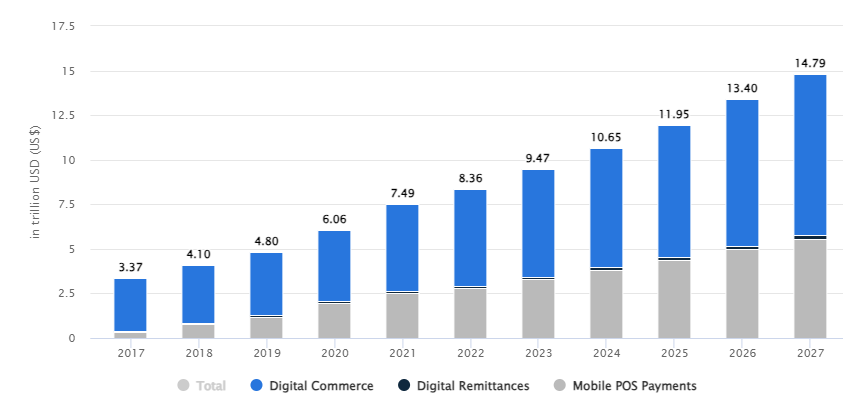Peer-to-peer (P2P) payment systems have become important instruments for quick, safe, and effective financial transactions in the rapidly changing world of digital finance. This article explores the nuances of P2P payment applications, clarifying their core traits, rising popularity, associated benefits, market entrance tactics, industry trends, how to build a p2p payment app, and related financial concerns.
Deciphering P2P: Peer-to-Peer
It is crucial to first explain the terminology: P2P stands for “Peer-to-Peer.” P2P refers, in the context of financial technology, to digital payment systems that enable people to send money directly to one another using a mobile application, doing away with the need for middlemen like conventional banking institutions.
The Anatomy of P2P Payment Apps
P2P payment apps can be identified by their key characteristics and organizational design:
User-Centric Interface
These programs have been painstakingly created to have a user-friendly interface that fosters an intuitive transaction experience and makes it possible to transfer money in a few easy steps.
Bank Integration
P2P payment programs provide a direct connection with users’ bank accounts, giving instant access to financial resources and obviating the need to preload a digital wallet.
Strict Security Protocols
These apps are reinforced with powerful encryption technologies and multi-factor authentication, upholding the principles of data protection and privacy while guaranteeing the highest level of security for users’ financial information.
Real-Time Transaction alerts
Users are informed of the status of each transaction via real-time alerts, enhancing system transparency and confidence.
Expense Division Functionality
Many peer-to-peer (P2P) programs provide a capability for easily dividing expenses, which makes it easier to split invoices, split rent payments, or organize contributions for group presents.
Card Linkage
A number of P2P payment programs make it possible to connect credit or debit cards, expanding the range of possible financial transactions.
The Resounding Popularity of P2P Payments
P2P payment apps have become more popular for the reasons listed below.
- Rapid Transaction Processing: P2P payments enable accelerated transaction processing that avoids the extended delays connected with checks and typical bank transfers, standing in sharp contrast to traditional procedures.
- Unmatched Convenience: The convenience that P2P payment systems offer is its distinguishing feature. Users may conduct transactions whenever they want, from wherever they are, making actual payment cards and currency unnecessary. According to a report by Statista, total transaction value in the Digital Payments market is projected to reach US$9.46tn in 2023. Here’s graph that breaks down transactional values by the segments of a digital payments market:

- Simplified Expense Sharing: These applications make it easier to divide expenditures, whether they relate to joint rent payments, eating expenses, or cooperative gift-giving.
- Security Assurance: By upholding strict security regulations, P2P applications encourage a sense of security and trust among users, which is supported by state-of-the-art encryption and fraud protection mechanisms.
The Advantages of P2P Payment Apps
The use of P2P payment apps has a number of benefits:
- Operational Efficiency: P2P transactions streamline financial transactions into a matter of seconds by avoiding traditional, time-consuming payment methods.
- Robust Financial Tracking: Users gain access to thorough transaction histories that enable them to keep a close eye on their financial outflows and inflows.
- Effortless Expense Division: P2P applications make it simple to divide expenses, making it easier to handle shared financial obligations.
- Enhanced Security: P2P apps use encryption and fraud protection tools to guarantee the security of financial data, fostering system confidence.
- Global Reach: Some programs provide cross-border money transfers, giving consumers an affordable substitute for conventional banking procedures.
Evolving Trends in the P2P Payment App Landscape
There are several dynamic trends and continuing innovations in the P2P payment app sector:
| Integration of cryptocurrencies | Contactless Payments | In-App Purchases | Biometric Authentication |
| P2P payment applications are starting to investigate the inclusion of cryptocurrencies, expanding the selection of choices for financial transfers. | As the world moves more and more toward cashless transactions, contactless payments are becoming more and more common. | As applications expand their capabilities, customers are now able to pay for goods and services within the apps themselves. | As a way to strengthen security measures, the sector is seeing an increase in the application of biometric authentication approaches, such as facial recognition and fingerprint scanning. |
Ingress into the P2P Payment App Market
The following road map is suggested for individuals thinking of entering the P2P payment app market:
- Market analysis: Thorough market research is necessary to understand your app’s target market, competitive environment, and unique selling propositions.
- Regulatory Adherence: Ensure that your application conforms with relevant financial rules by navigating the intricate legal and regulatory framework.
- Development Project: Work with skilled developers to create a safe and usable application that meets user requirements.
- Testing and Iteration: Conduct beta testing to get user feedback that may be used to improve the user experience of the program.
- Strategic Marketing: Develop a thorough marketing plan to raise awareness of and draw customers to your app.
- Launch and Sustained Growth: To encourage sustained growth after the application’s launch, concentrate on user acquisition, engagement, and retention.
The Blueprint for a Flourishing P2P Payment App
Take into account the following tactics to make sure your P2P payment application is successful and long-lasting:
| User-Centric Design | Give top priority to a user-friendly interface and experience, which is essential for retaining and satisfying users. |
| Security Fortification | Allocate funds to comprehensive security measures to bolster the protection of user data and transactions. |
| Responsive Customer support | Develop a quick-response system for customer assistance to resolve consumer complaints and problems. |
| Innovative Evolution | Stay on the cutting edge of technical development and think about adding cutting-edge features to meet changing consumer requests. |
| Integration of user input | Use user feedback as a useful tool for continuing improvements and tweaks. |
Understanding the Financial Outlay
Let’s finish by talking about the crucial issue of money matters while developing P2P payment apps. The expenses are complex and dependent on a number of important aspects, including:
- Development Team: Whether in-house or outsourced development is chosen has an impact on development expenses.
- Feature Set: The cost is directly impacted by the complexity of features, such as in-app purchases, international transfers, and cryptocurrency integration.
- Security Investment: Although necessary, strong security measures come at an additional cost.
- Ongoing Maintenance: A budget is required for maintenance and upgrades, which are essential for the longevity of the application.
- Marketing Activities: Invest funds in advertising and marketing activities to make sure your application reaches the target market.
- Legal Compliance: Take care of the associated legal and regulatory costs, especially when managing financial transactions.
Conclusion
P2P payment programs have transformed the banking industry by providing users with a safe, effective, and practical way to transact money. Successful entry into this expanding industry requires careful preparation, adherence to security and user experience standards, and a thorough grasp of the financial concerns involved. Although there is great promise, there are also several difficulties.
Featured image provided by Unsplash; Thanks!





























